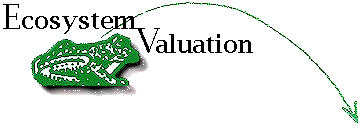



 |

|

Essentials, Section 3
Overview of Methods to Estimate Dollar Values
This section gives a brief overview of the dollar-based valuation methods that are described in detail in Dollar-Based Ecosystem Valuation Methods.
There are three generally accepted approaches
to estimating dollar values of ecosystem services. Each approach
includes several methods. They are:
1. Market Prices ・ Revealed Willingness to Pay
The values of some ecosystem goods or services can be measured using market prices. Some ecosystem products, such as fish or wood, are traded in markets. Thus, their values can be estimated by estimating consumer and producer surplus, as with any other market good. Other ecosystem services, such as clean water, are used as inputs in production, and their value may be measured by their contribution to the profits made from the final good.
Some ecosystem or environmental services,
like aesthetic views or many recreational experiences, may not be directly
bought and sold in markets. However, the prices people are willing
to pay in markets for related goods can be used to estimate their values.
For example, people often pay a higher price for a home with a view of
the ocean, or will take the time to travel to a special spot for fishing
or bird watching. These kinds of expenditures can be used to place
a lower bound on the value of the view or the recreational experience.
These methods include:
Market Price Method
Productivity Method
Hedonic Pricing Method
Travel Cost Method
2. Circumstantial Evidence ・ Imputed
Willingness to Pay
The value of some ecosystem services can
be measured by estimating what people are willing to pay, or the cost of
actions they are willing to take, to avoid the adverse effects that would
occur if these services were lost, or to replace the lost services.
For example, wetlands often provide protection from floodwaters.
The amount that people pay to avoid flood damage in areas similar to those
protected by the wetlands can be used to estimate willingness to pay for
the flood protection services of the wetland.
These methods include:
Damage Cost Avoided, Replacement Cost, and Substitute Cost Methods
3. Surveys ・ Expressed Willingness to Pay
Many ecosystem services are not traded in markets, and are not closely related to any marketed goods. Thus, people cannot ・reveal・ what they are willing to pay for them through their market purchases or actions. In these cases, surveys can be used to ask people directly what they are willing to pay, based on a hypothetical scenario. Alternatively, people can be asked to make tradeoffs among different alternatives, from which their willingness to pay can be estimated.
These methods include:
Contingent Valuation MethodContinue to:
Contingent Choice Method
Section 4 ・ Applying Ecosystem Valuation Estimates・ Benefit-Cost Analysis
Back to:
Section 2 ・ Valuation of Ecosystem Services
Back to:
Essentials of Ecosystem Valuation







